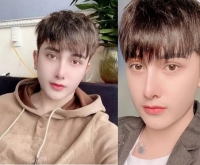I have been getting alot of people ask me this recently so I figure Ill do a post with photos explaining in as detailed as possible. An ideal candidate for facial contouring is someone who meets the following criteria:
1) Relatively small facial bones
2) Thin tissues (thick tissues can conceal the contour of the final result)
3) Protruding facial bones (Note that there's a difference between having a big face because your facial bones are overall naturally wide, versus having a big face because your facial bones are protruding.
If you look at the first photo, the red line depicts the point in which actual facial bone protrusion is present. This should give indication of how much bone manipulation is possible. The surgeon can realistically only resect the bones within this guideline. The reason why the surgeon cannot go beyond this limitation is because doing so will damage the facial nerves and connective tissues, including the motor nerves. Damaging motor serves = you look like you have a stroke. Note the location of the facial nerves in the Diagram picture. But also note that facial nerves also run under the bone too through to the inner cheek wall.
Now for the zygoma reduction many surgeons will explain it to the patient as "pushing in" the bone. What they really mean is, resection is performed via a clean fracture which then reattaches the bone with titanium wiring, screws or patented pin (depending on the technique used). The limitaton to which the width of the zygoma can be reduced is towards the temple line.
When it comes to mandible reduction, the surgeon cannot "push" the bones inwards. That's not possible because of how lower jaw is connected to the upper jaw AND there are huge motor nerves running through that region. Bear in mind that width is only altered via bone resection IF there is protrusion. A patient with no bone protusion will only yield changes in the SHAPE of their square jaw and NOT the width. However, even if a patient has no bone protrusion at the mandible angle and has overall naturally wide facial bones like the asian lady in the picture (her face isnt actually considered big btw but I used that picture to depict facial bones which are NOT ideal for facial contouring), if width is partially due to jaw MUSCLES, then jaw botox will make a noticable improvement. Patients with bone structures like the asian lady really dont have much room to "push" the zygoma inwards, nor will they see width improvements from mandible resection, only a change in shape will be yielded. Once more, the width can be reduced via botox IF strong and large facial muscles are present.
I also edited the picture of the actress to give an idea of how much change is possible for someone who is an ideal candidate, by changing her features according to her anatomical structural guidelines. In constrast if you look at the facial structure of the asian lady, I am sure you can tell the differences and why a patient with her structure would never yield much improvement.
Another important thing to note
If you are NOT an ideal candidate, be prepared to expect premature aging. There is a reason why these procedures are seldom performed on older patients. Premature aging / sagging is dependant on the follow:
1) Does the patient have bone protusion?
2) The laxity of the patient's facial muscles/tissues. Remember, the bones are the structure holding these in place. Once this has been altered sagging will occur in both ideal and non-ideal candiates. However those who are NOT ideal candidates will experience premature aging to a greater extent
3) age of the patient as these coincides with point number 2.
Note: Premature aging / sagging is may not be noticeable soon after surgery. Some notice it a year after surgery, whilst some take longer to notice it. It just depends on the laxity of your facial muscles / tissues. I only noticed my jowels sagging well over a year after my surgery.
So at the end of the day its for the patient to have realistic expectations, and consider "IF i am not the ideal candidate, am I willing to undergo these procedures knowing my results will not be the most ideal AND I will have to deal with premature aging at some point". I personally believe if the patient is mentally prepared to have a face lift later on, then it shouldnt be much of an issue. However, note that the facelift should not be done at the same time or too soon after facial contouring. For example, Mrsking who used to be active here years ago, did her facial contouring and lifting at the same time and ended up with inaccurate results from the facelift. The ONLY form of lifting you can do at the same time ONLY works for together with the zygoma reduction. Its called a periostiem lift and it mitigates sagging which occurs post zygoma reduction. It does not address the jowels. Hence, given that, its probably best to just do a full on smas lift seperately as a the smas will address both the upper and lower face / jowels at the same time.
View attachment 5314126
View attachment 5314149
View attachment 5314150
View attachment 5314151






